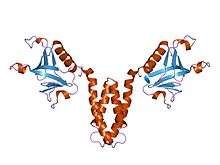Signal transducing adaptor protein

Signal transducing adaptor proteins (STAPs) are proteins that are accessory to main proteins in a signal transduction pathway.[1] Adaptor proteins contain a variety of protein-binding modules that link protein-binding partners together and facilitate the creation of larger signaling complexes. These proteins tend to lack any intrinsic enzymatic activity themselves,[2] instead mediating specific protein–protein interactions that drive the formation of protein complexes. Examples of adaptor proteins include MYD88, Grb2 and SHC1.
Signaling components
Much of the specificity of signal transduction depends on the recruitment of several signalling components such as protein kinases and G-protein GTPases into short-lived active complexes in response to an activating signal such as a growth factor binding to its receptor.
Domains
Adaptor proteins usually contain several domains within their structure (e.g., Src homology 2 (SH2) and SH3 domains) that allow specific interactions with several other specific proteins. SH2 domains recognise specific amino acid sequences within proteins containing phosphotyrosine residues and SH3 domains recognise proline-rich sequences within specific peptide sequence contexts of proteins.
There are many other types of interaction domains found within adaptor and other signalling proteins that allow a rich diversity of specific and coordinated protein–protein interactions to occur within the cell during signal transduction.
Genes
Genes encoding adaptor proteins include:
- BCAR3 – Breast cancer anti-estrogen resistance protein 3
- GRAP – GRB2-related adaptor protein
- GRAP2 – GRB2-related adaptor protein 2
- LDLRAP1 – low-density lipoprotein receptor adaptor protein 1
- MYD88 - Myeloid differentiation primary response gene 88
- NCK1 – NCK adaptor protein 1
- NCK2 – NCK adaptor protein 2
- NOS1AP – nitric oxide synthase 1 (neuronal) adaptor protein
- PIK3AP1 – phosphoinositide-3-kinase adaptor protein 1
- SH2B1 – SH2B adaptor protein 1
- SH2B2 – SH2B adaptor protein 2
- SH2B3 – SH2B adaptor protein 3
- SH2D3A -SH2 domain containing 3A
- SH2D3C – SH2 domain containing 3C
- SHB – Src homology 2 domain containing adaptor protein B
- SLC4A1AP – solute carrier family 4 (anion exchanger), member 1, adaptor protein
- GAB2 – GRB2-associated binding protein 2
See also
References
- ↑ "Role of Signal Transducing Adaptor Protein (STAP) Family in Chronic Myelogenous Leukemia". Retrieved 24 August 2018.
- ↑ Signal+Transducing+Adaptor+Proteins at the US National Library of Medicine Medical Subject Headings (MeSH)
Further reading
- TAB2 is an adaptor protein involved in the IL-1 signal transduction pathway: Takaesu G, Kishida S, Hiyama A, Yamaguchi K, Shibuya H, Irie K, Ninomiya-Tsuji J, Matsumoto K (April 2000). "TAB2, a novel adaptor protein, mediates activation of TAK1 MAPKKK by linking TAK1 to TRAF6 in the IL-1 signal transduction pathway". Molecular Cell. 5 (4): 649–58. doi:10.1016/S1097-2765(00)80244-0. PMID 10882101.
- Good article about adaptor proteins involved in protein kinase C-mediated signal transduction: Schechtman D, Mochly-Rosen D (October 2001). "Adaptor proteins in protein kinase C-mediated signal transduction". Oncogene. 20 (44): 6339–47. doi:10.1038/sj.onc.1204778. PMID 11607837.
- A good article regarding the role of adaptor proteins involved with the T-cell antigen receptor: Samelson LE (2002). "Signal transduction mediated by the T cell antigen receptor: the role of adapter proteins". Annual Review of Immunology. 20 (1): 371–94. doi:10.1146/annurev.immunol.20.092601.111357. PMID 11861607.
- Signalling discussed with regards to adaptor proteins: Pawson, T. (1997). "Signaling Through Scaffold, Anchoring, and Adaptor Proteins". Science. 278 (5346): 2075–2080. doi:10.1126/science.278.5346.2075. ISSN 0036-8075.